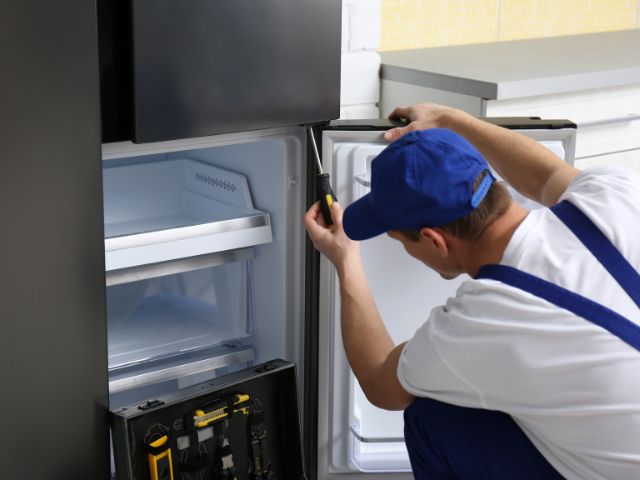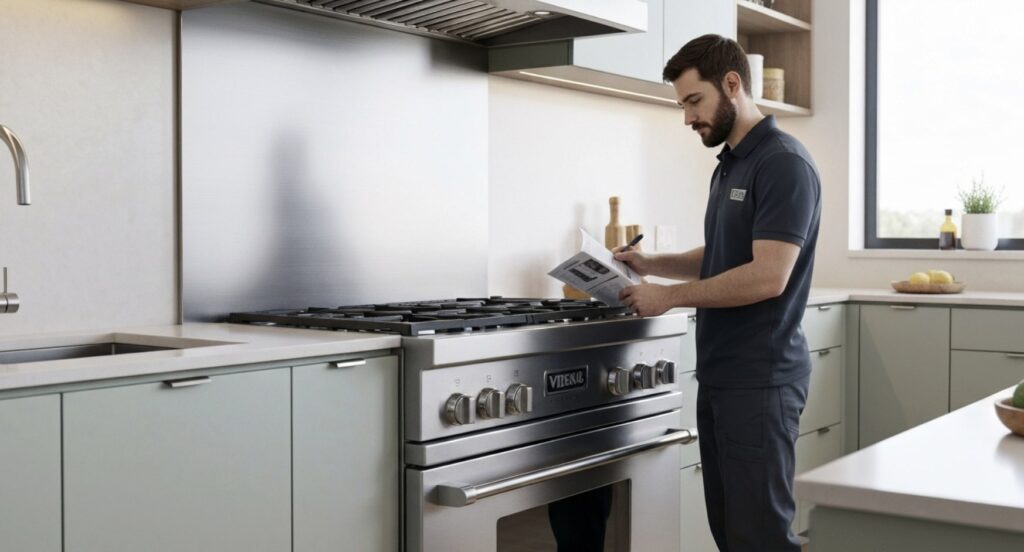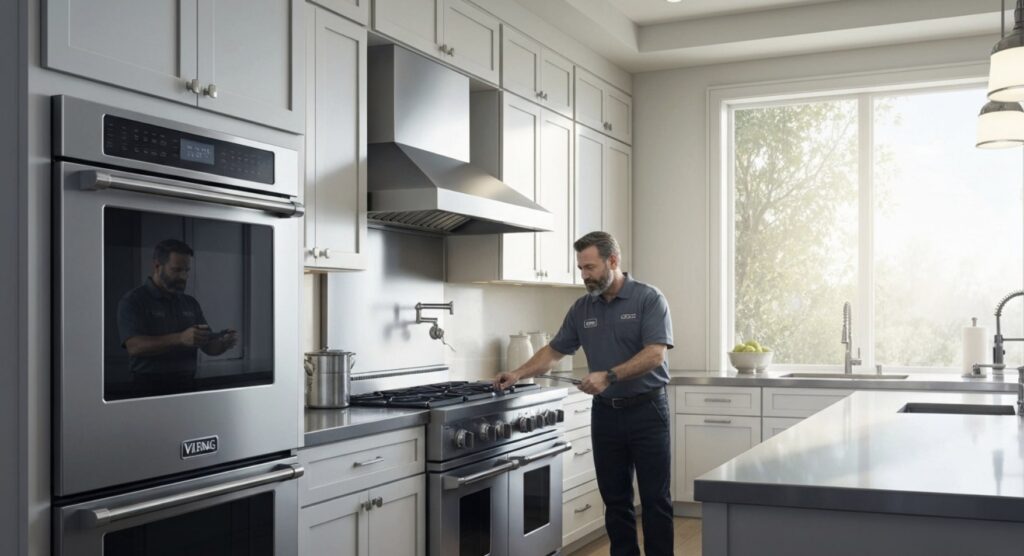The water dispenser in the Viking refrigerator is a must-have in today’s kitchens. It gives easy access to cold water. But, like any appliance, it can have issues that can interrupt our everyday life. This guide will help you troubleshoot common refrigerator water dispenser problems. We will show you how to spot trouble signs, do quick checks, and follow simple steps to fix it.
Identifying Common Refrigerator Water Dispenser Issues
A faulty water dispenser can show problems in different ways. You may see less water coming out, warm water, or no water at all. You might also notice leaks around the dispenser or strange sounds when it works.
When you spot these early signs, you can fix the problem quickly. These issues often come from simple reasons that you can fix with a few basic troubleshooting steps.
Signs Your Refrigerator Dispenser Needs Attention
To stop more damage and trouble, keep an eye out for these signs:
- Reduced or no water flow: This often means there is a clog somewhere, possibly in the water filter, lines, or the dispenser itself.
- Water not cold enough: This may show a problem with how the water line connects to the refrigerator’s cooling system or with the temperature control being off.
- Leaking water: Look for leaks around the dispenser, under the refrigerator, or inside the refrigerator compartment. It could happen because of a cracked water line, a loose connection, or a bad water inlet valve.
- Unusual noises: Sounds like grinding, buzzing, or clicking when the dispenser is running might mean the water inlet valve is failing or that there is a problem with the dispenser control board.
- Foul taste or odor: If the water you get has a bad taste or smell, it usually means it’s time to change the water filter.
Quick Checks Before Deep Troubleshooting
Before you think something is really wrong, here are some simple checks to save you time and effort:
- Check the water filter: A dirty filter can block water flow. If you haven’t replaced it in a while (usually every six months), put in a new one.
- Inspect the water line: Make sure the line that connects the fridge to the home’s water is tightly connected, not bent, and not damaged.
- Examine the dispenser lever or buttons: Ensure there is nothing blocking the lever or buttons so they can work properly.
- Check the child lock feature: Many fridges have a child lock to stop accidental use. Make sure it is turned off.
- Power cycle the refrigerator: Unplug your fridge for a few minutes. This will reset the system, then plug it back in.
Step-by-Step Solutions for Water Dispenser Problems
If the basic checks do not fix the problem, you may need to look deeper. Here is a simple guide to help you with more complex water dispenser issues:
Always unplug the refrigerator before trying any repairs with electrical parts. It’s a good idea to check your refrigerator’s user manual for instructions that fit your model and safety tips.
Checking for clogged water lines or filters
Clogged water lines and dirty filters often cause problems with dispensers.
First, look at the water filter. If you see it is dirty or blocked, replace it with a new one. Next, check the water line that connects to the refrigerator. Look for any kinks or bends that could block the water flow. If you find any, straighten the line if you can, or replace it if it is damaged.
For tough clogs, you can flush the water line using a mix of vinegar and water. This can help remove mineral buildup and other debris blocking the water flow.
Adjusting the temperature settings
If the water you get isn’t cold enough, the issue might be with the temperature settings.
First, check the temperature control settings in your refrigerator. Make sure the temperature in the refrigerator is between 37°F and 40°F. If it is too warm, the water won’t chill enough.
Also, make sure the water line in the refrigerator is well connected to the cold water supply. A loose connection or wrong setup can cause the water not to cool properly.
Inspecting the water inlet valve
The water inlet valve is what controls the water flow into the refrigerator. If this valve is damaged, it can cause problems with the dispenser.
Check the valve for damage, leaks, or any buildup of minerals. If you notice any problems, it is better to replace it with a new valve. To reach the valve, which is usually at the back of the refrigerator, you may need to take off a panel or two. Don’t forget to unplug the refrigerator first.
You can also test the valve with a multimeter. This can help you see if there is electrical continuity. If there is no continuity, it means the valve is likely broken and needs to be replaced.
Replacing the dispenser control board or switch
The dispenser control board manages the electrical signals to the parts of the dispenser. The dispenser switch turns the water flow on and off. Problems with either of these can stop the dispenser from working properly.
If the control board is failing, you might see different signs. This can include strange behavior of the dispenser or it not working at all. If you think there is a problem with the control board, it’s usually best to replace it.
A broken dispenser switch can stop the signal that allows water to flow. You can test the switch with a multimeter. This will help you decide if you need to replace it.
Defrosting the water reservoir and dispenser line
In colder areas, water in the dispenser line or reservoir can freeze. This stops the water from flowing.
If you think freezing has happened, you can use a hairdryer on low heat to warm up the frozen parts. You might also unplug the refrigerator and let the ice melt on its own.
After the ice is gone, plug the refrigerator back in and see if the dispenser works again. To stop this from happening in the future, make sure the refrigerator’s temperature is set right. Also, look for drafts or leaks of cold air that could affect the dispenser line.
Conclusion
In conclusion, refrigerator water dispenser problems can be frustrating to deal with, but there are several troubleshooting steps you can take to address the issue. Testing the valve for continuity and replacing it if necessary, checking and replacing the dispenser control board or switch, and defrosting any frozen water reservoir or dispenser line are all effective solutions. By following these steps and ensuring the refrigerator is properly maintained, you can resolve water dispenser issues and enjoy a fully functional appliance. For more fridge tips, check out our blog on How to Fix a Viking Refrigerator Not Defrosting.
Frequently Asked Questions
How often should I replace the water filter to prevent issues?
To keep your water dispenser working well and to ensure good water quality, you should change the water filter every six months. However, check your refrigerator’s user manual for details that are specific to your model.
Can a damaged water inlet valve affect the water dispenser?
A broken water inlet valve can really harm the water dispenser. It may slow down or stop the water flow entirely. This can result in weak water dispensing or no water at all. It could also cause leaks.
How can I prevent my refrigerator water lines from freezing?
Make sure the refrigerator is set to the right temperature. Also, check that the doors are sealed well to keep cold air inside. Don’t push the refrigerator too close to the wall. This can block airflow and may cause freezing.






